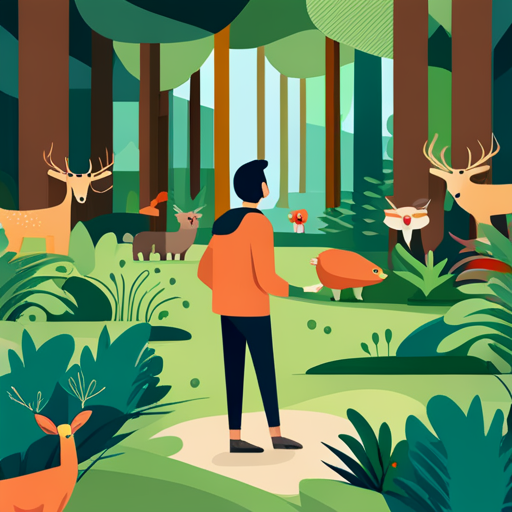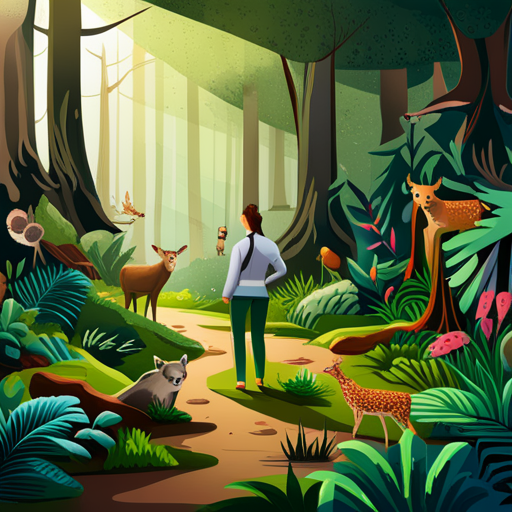Are you passionate about animals and the environment?
Do you dream of a career where you can make a difference in the world while getting paid to do what you love? Look no further than the field of wildlife biology.
As a wildlife biologist, you have the unique opportunity to track animal populations and habitats, contributing to the conservation and protection of our planet’s biodiversity.
In this article, we will explore the role of a wildlife biologist and the educational requirements to pursue this rewarding career. Finally, we will discuss the salary prospects for wildlife biologists, proving that you can follow your passion while also earning a living.
So, if you’re ready to embark on a journey of discovery and contribute to the well-being of our natural world, join us as we dive into the world of wildlife biology.
How Much Money Do Wildlife Biologists Make?
| Reference Link | Salary |
|---|---|
| EnvironmentalScience.org | $66,350 as of May 2020 |
| ZipRecruiter | $78,000 (25th percentile) to $108,500 (75th percentile) with top earners (90th percentile) making $118,000 annually across the United States |
| Zippia | The average salary for a wildlife biologist is $51,084 in the US. The average wildlife biologist salary ranges between $34,000 and $75,000 in the US. Hourly rates for wildlife biologists in the US typically range between $16 and $36 an hour. The average wildlife biologist salary is $69,621 in Alaska, $68,197 in Oregon, and $62,983 in Washington. |
| FederalPay.org | In 2021, the Forest Service hired the most employees titled Wildlife Biology, with an average salary of $80,046 |
The Role of a Wildlife Biologist
Being a wildlife biologist means getting paid to explore and monitor animal populations and habitats. As a wildlife biologist, you have the important responsibility of studying and understanding the behavior, distribution, and abundance of various species.
By tracking animal populations, you play a crucial role in ensuring the conservation and preservation of wildlife.
Wildlife biologist responsibilities go beyond simply observing animals. You also assess the health of ecosystems and evaluate the impact of human activities on wildlife habitats.
Through your work, you contribute to the development of management plans and conservation strategies to protect endangered species and maintain biodiversity. Your efforts help maintain the delicate balance of nature and ensure that future generations can continue to enjoy the beauty and diversity of wildlife.
It’s important to note that becoming a wildlife biologist requires a strong educational background in biology, ecology, or a related field.

Educational Requirements for Wildlife Biologists
To become a wildlife biologist, you’ll need a strong educational background in biology and a passion for studying the natural world. A Bachelor’s degree in biology or a related field is typically required to enter this field.
During your undergraduate studies, you’ll learn about topics such as ecology, animal behavior, and conservation. These courses will provide you with a solid foundation of knowledge that you can apply to your future work as a wildlife biologist.
In addition to a degree, field experience is also important in this field. This can include internships, volunteer work, or research projects. Field experience allows you to gain hands-on experience working with animals in their natural habitats, and it helps you develop important skills such as data collection and analysis.
By combining your educational background with field experience, you’ll be well-prepared to pursue a career as a wildlife biologist and make a meaningful impact in the field of conservation.
As you transition into the subsequent section about tracking and monitoring animal populations, it’s important to note that obtaining a strong educational background and field experience is just the first step.
Once you have these foundational skills, you’ll be ready to delve into the exciting work of tracking and monitoring animal populations and habitats.
Here’s a table of courses, prices and description
| School – Location | Course Description |
|---|---|
| Colorado State University – Fort Collins $12,012 (in-state), $30,985 (out-of-state) | The Department of Fish, Wildlife, and Conservation Biology at Colorado State University offers a Bachelor of Science in Fish, Wildlife, and Conservation Biology. The program provides students with a strong foundation in the biological and ecological sciences and prepares them for careers in natural resource management and conservation. Students can choose from several areas of emphasis, including conservation biology, fishery biology, wildlife biology, and zoology. Graduate students can pursue a Master of Science or a Ph.D. in Fish, Wildlife, and Conservation Biology. |
| University of Montana – Missoula $7,472 (in-state), $27,353 (out-of-state) | The University of Montana offers a Bachelor of Science in Wildlife Biology through the W.A. Franke College of Forestry & Conservation. The program provides students with a strong foundation in the biological and ecological sciences and prepares them for careers in natural resource management and conservation. Students can choose from several areas of emphasis, including conservation biology, fishery biology, wildlife biology, and zoology. Graduate students can pursue a Master of Science or a Ph.D. in Wildlife Biology. |
| University of Georgia – Athens $12,080 (in-state), $31,120 (out-of-state) | The Warnell School of Forestry and Natural Resources at the University of Georgia offers a Bachelor of Science in Wildlife Sciences. The program provides students with a strong foundation in the biological and ecological sciences and prepares them for careers in natural resource management and conservation. Students can choose from several areas of emphasis, including conservation biology, fishery biology, wildlife biology, and zoology. Graduate students can pursue a Master of Science or a Ph.D. in Wildlife Sciences. |
| Oregon State University – Corvallis $11,715 (in-state), $31,215 (out-of-state) | The Department of Fisheries and Wildlife at Oregon State University offers a Bachelor of Science in Fisheries and Wildlife Sciences. The program provides students with a strong foundation in the biological and ecological sciences and prepares them for careers in natural resource management and conservation. Students can choose from several areas of emphasis, including conservation biology, fishery biology, wildlife biology, and zoology. Graduate students can pursue a Master of Science or a Ph.D. in Fisheries and Wildlife Sciences. |
| University of California – Davis $14,597 (in-state), $44,491 (out-of-state) | The Department of Wildlife Fish & Conservation Biology at the University of California-Davis offers an undergraduate major in Wildlife Fish & Conservation Biology that provides students with an understanding of the ecology and management of wild animals and their habitats as well as the social context within which wildlife management decisions are made. Graduate students can pursue a Master’s degree or Ph.D. degree in Ecology or Animal Behavior. |
Tracking and Monitoring Animal Populations
One of the key aspects of being a wildlife biologist is understanding how to track endangered species. This involves using various techniques such as radio tracking, satellite tagging, and camera traps to gather data on the movements and behaviors of these animals.
By monitoring these populations, you’ll be able to observe how climate change is affecting their behaviors, reproductive patterns, and overall health.
You’ll also have the opportunity to delve deeper into the intricate relationships between animals and their environment.
Researching Animal Behavior and Habitat
Explore the intricate relationships between animals and their environment by researching their behavior and habitat. As a wildlife biologist, you have the unique opportunity to delve into the fascinating world of animal conservation through field research.
By studying how animals behave and interact with their surroundings, you gain valuable insights into their needs, preferences, and overall well-being. Your work not only contributes to the preservation of various species but also helps us better understand the delicate balance of ecosystems and the impact of human activities on wildlife.
Through your research, you uncover the hidden secrets of animal behavior, uncovering patterns and adaptations that have evolved over centuries. You observe their daily routines, mating rituals, and foraging strategies, all while considering the influence of environmental factors such as climate change and habitat loss.
By studying animal behavior, you can anticipate their responses to different situations and develop strategies for their protection. Additionally, your research on animal habitats provides crucial information for conservation efforts, helping to identify areas that need protection, restoration, or management. By understanding the specific requirements and preferences of different species, you can contribute to creating sustainable environments that support diverse wildlife populations.
Transitioning into the subsequent section about ‘salary prospects for wildlife biologists,’ you can see that your passion for researching animal behavior and habitat not only fulfills your desire for understanding but also offers promising career opportunities.
Wildlife Biologists Job Prospects
As a wildlife biologist, you can find yourself at the forefront of the job market, where the demand for your expertise is constantly growing. With increasing concerns about environmental conservation and the need to protect and manage wildlife populations, there is a high demand for professionals who can track animal populations and habitats.
Your skills and knowledge will be highly sought after, providing you with a stable and rewarding career.
In addition to the promising job market, advancements in wildlife tracking technology have further enhanced the salary prospects for wildlife biologists. With the development of sophisticated tracking devices and remote sensing technologies, you’ll have access to cutting-edge tools that allow you to gather accurate data on animal movements and behaviors.
Your ability to utilize these advanced technologies will set you apart from others in the field, enabling you to command a higher salary and pursue exciting opportunities in both academic and applied research.
So, if you have a passion for wildlife and a desire to make a difference, a career as a wildlife biologist not only allows you to study animal behavior and habitat but also offers promising salary prospects in a growing job market.
What Is the Difference Between a Silviculturist and a Wildlife Biologist?
A silviculturist focuses on managing forests and developing sustainable practices, while a wildlife biologist studies animal behavior and habitats. Both careers contribute to conservation efforts, but their areas of expertise vary. Silviculturists primarily work on forest-related projects, such as reforestation and tree growth, while wildlife biologists concentrate on studying wildlife populations. Silviculturist job opportunities and salaries are typically found in forestry and natural resource management sectors, whereas wildlife biologists have prospects in research, environmental consulting, and government agencies.
Conclusion
In conclusion, pursuing a career as a wildlife biologist can be an incredibly fulfilling and rewarding path. Wildlife biologists play an important role in tracking and monitoring animal populations and habitats.
By studying animal behavior and habitat, you’ll have the opportunity to contribute valuable insights to conservation efforts.
While the educational requirements are important, your passion for wildlife and dedication to making a difference will guide you through the necessary steps.
Additionally, the salary prospects for wildlife biologists can be quite promising. True it may take time and experience to reach higher earning potential, but your dedication and expertise will be recognized and rewarded. So, if you have a passion for animals, a curiosity about their behavior and habitat, and a desire to make a difference in the world, a career as a wildlife biologist may be the perfect fit for you.
